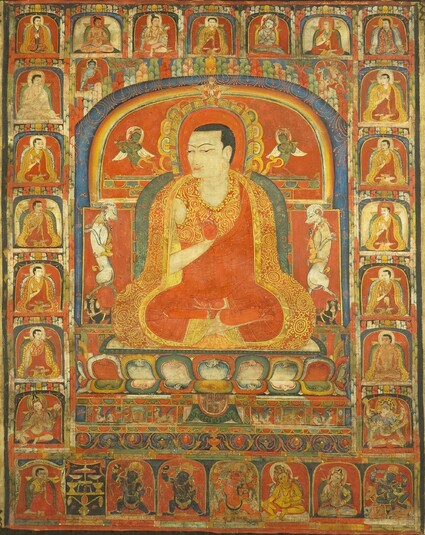
Item: Teacher (Lama) - Tashi Lama
| Origin Location | Tibet |
|---|---|
| Date Range | 1200 - 1299 |
| Lineages | Kagyu, Taklung (Kagyu) and Buddhist |
| Material | Ground Mineral Pigment on Cotton |
| Collection | Private |
Classification: Person
Appearance: Monastic
Gender: Male
Tashi Lama (Mangala Guru, 1231-1297), 4th Abbot p8428: Taglung Kagyu teacher of the 13th century.
To his proper right are Tilopa, Naropa, Marpa, Milarepa, Gampopa and Pagmodrubpa. On his proper left are Vajradhara, Atisha and Dromton. Descending from Dromton is possibly the figure of Gampopa followed by Pagmodrubpa. (See other Indian Style Paintings).
There is a lengthy inscription of blessing, in the shape of a stupa, on the back of the painting. Included in the blessing written in both Tibetan and Sanskrit language is a name mantra for the centrally depicted figure on the front of the painting. In Sanskrit the name reads 'ratna natha' - meaning 'Rinchen Gonpo' in Tibetan. Again on the back, at the top, is a single one line inscription stating that the painting was further blessed by Sanggye Yarjon (1203-1272) [p1818]. (Blessed by the precious Onpo teacher of Taglung. stag lung pa'i dbon po bla ma rin po che dpal gyi rab gnas bzhugs).
At the bottom left is an unidentified donor figure. Following to the right is wrathful Krodha Vajrapani holding a vajra upraised in the right hand. Achala belonging to the Atisha tyradition is depicted in a standing posture, holding a sword in the right hand. In the middle of the register is red Hayagriva with one face and four hands. To the right again are two wealth deities. The first is Yellow Jambhala and the second is White Aparajita. In the bottom right corner is Shri Devi according to the uncommon tradition of the mahasiddha Naropa.
Western art historians refer to the style of painting as Taglung (or Taklung). The word Taglung, or more formally stated as Taglung Kagyu, a religious tradition, one among many, that began in the late 12th century. Other religious traditions also employed this and similar painting styles. It was not exclusive nor original to the Taglung Tradition.
Taglung Lineage: Tilopa, Naropa, Marpa Chokyi Lodro, Milarepa Zhepa Dorje, Gampopa Sonam Rinchen, Pagmodrubpa Dorje Gyalpo (1110-1170) [p127], Taglung Tangpa Chenpo Tashi Pal (1142-1209/10) [p2649], Kuyalwa (Onpo) Rinchen Gonpo (1191-1236) [p1784], Sanggye Yarjon (1203-1272) [p1818], Tashi Lama (Mangala Guru, 1231-1297) [p8428], Others....
Jeff Watt 1-2013
Partial Lineage List:
1. Vajradhara
2. Tilopa
3. Naropa
4. Marpa
5. Milarepa
6. Gampopa
7. Pagmodrubpa
8. Taglung Tangpa Chenpo
9. Kuyalwa Rinchen Gonpo
---------------------------- 10. Atisha
11. Dromton
12. Gampopa
13. Pagmodrubpa
14. Unidentified
15. Unidentified
16. Unidentified
17. Unidentified
18. Unidentified
Numbered List: (The numbered list that follows does not attempt to recreate the hierarchy of the two different lineages that are represented and begin in the top register).
1. Marpa
2. Naropa
3. Tilopa
4. Taglung Tangpa Chenpo, Tashi Pal
5. Vajradhara
6. Atisha, Indian Teacher (monk)
7. Dromton, Tibetan Teacher (layman)
8. Milarepa
9. Gampopa (monk)
10. Gampopa (monk)
11. Pagmodrubpa, Tibetan Teacher (monk)
12. Tibetan Teacher (monk)
13. Tibetan Teacher (monk)
14. Tibetan Teacher (monk)
15. Tibetan Teacher (monk)
16. Tibetan Teacher (monk)
17. Tibetan Teacher (monk)
18. Avalokiteshvara (deity)
19. Ushnishavijaya (long life deity)
20. Donor Figure
A. Medicine Buddha
B. Figure (unidentified)
C. Krodha Vajrapani (deity)
D. Achala (Atisha Tradition, deity)
E. Hayagriva (deity)
F. Yellow Jambhala (wealth deity)
G. Aparajita (wealth deity)
H. Shri Devi (protector deity)
Collection: Private 1
Subject: Lineage Paintings - Dual
Subject: Lineage Paintings (Kagyu/Kadam)
Tradition: Taglung Kagyu Main Page
Teachers: Early Paintings of Teachers (Indian Style)
Teachers: Early Teachers (Right Facing)
Teachers: Early Teachers (Single Figures)
Teacher: Tashi Lama (Mangala Guru)




